|
In February, the Center for Democracy, Human Rights, and Governance (DRG Center) was pleased to organize the 2023 DRG Annual Learning Forum. Across the six virtual sessions, more than 500 unique participants worldwide joined from USAID, implementing partners, donors and other stakeholders to engage with academics and practitioners to share evidence, approaches, and key programming implications. This year’s Forum highlighted progress regarding the research on USAID’s 2021-2023 DRG Learning Agenda.
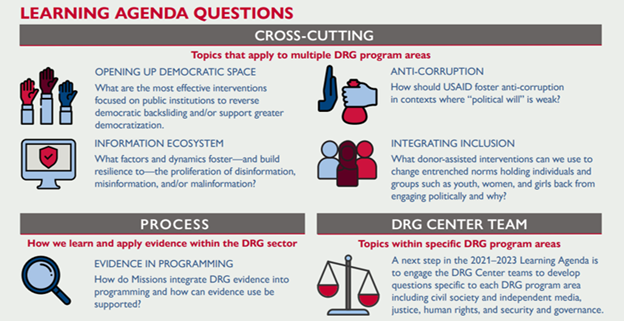 USAID’s 2021-2023 DRG Learning Agenda Questions
This edition of the DRG Learning Digest examines the following four topics that were the focus of this year’s Forum:
- Glaring deficit of high-quality evidence in misinformation, disinformation, and malinformation (MDM) programming in the Global South.
- Partnership, information transparency, and engagement are key to integrating anti-corruption efforts in USAID programming across multiple sectors.
- Careful deployment of DRG sub-sectoral tactics and tools is critical to resisting democratic backsliding.
- New tools to integrate evidence, evaluation, and learning into DRG programs.
Glaring Deficit of Evidence in MDM Programming in the Global South
The “Making Sense of Information Disorder” session focused on how to understand the problem of MDM and identifying evidence on effective programming solutions. Researchers from the University of Houston’s Hobby School of Public Affairs, American University, Brown University, and Dartmouth College organized key interventions into four categories and previewed findings on the efficacy of inoculation interventions in the Global North and South. Based on meta-analyses and systematic reviews, the research team developed a list of 21 key interventions and then organized these into four categories: Informational, Socio-psychological, Educational, and Institutional interventions. Based on the initial sampling of literature, most of the research on MDM interventions focuses on the Global North and there remains a gap in coverage of Global South countries. For example, the team reviewed 27 inoculation studies from the Global North, including a meta-analysis of 54 studies. In contrast, only four studies from three Global South countries (India, South Africa, and Brazil) were identified.
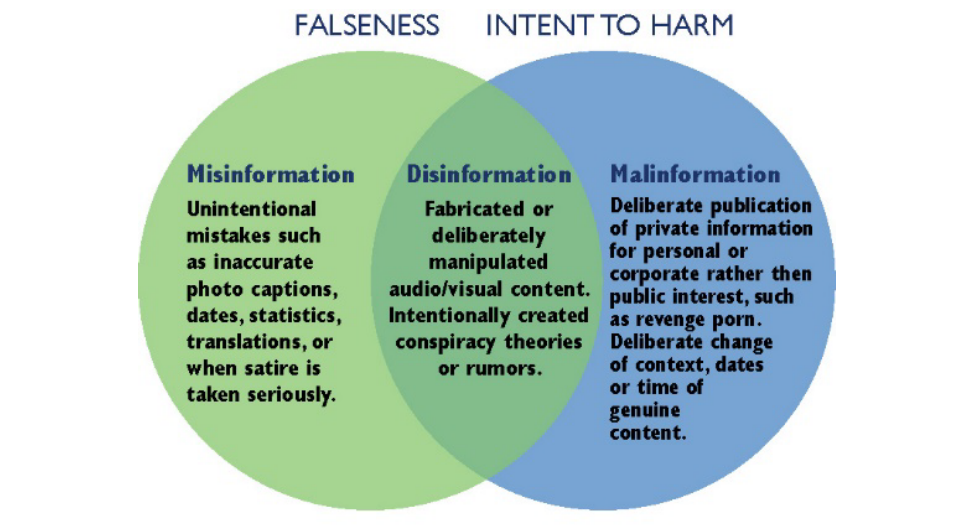 Types of Mis/Dis/Mal-Information. Source: https://internews.org/impact/disinformation
 Four MDM intervention categories. Source: Annual Learning Forum Session Slides
Inoculation interventions appear effective but relevant context – including variations in overall literacy, media literacy, and digital literacy – is key. In the Global North, inoculation interventions resulted in greater propensity to rate fake news as unreliable, reduced self-reported intention to share misinformation, and increased beliefs about scientific consensus. However, without boosting, inoculation effects fade within a few weeks or months, and interventions with general refutations are less effective than specific prebunking messages when followed by misinformation. From the Global South, research shows that inoculation-style exposure to fact-checks can reduce subsequent rumor acceptance in Brazil and improve discernment between true and false stories in South Africa and India. However, in India there were null findings using a one-shot experiment with a representative sample, and repeated interventions increase skepticism toward true news.
USAID’s DRG Center continues to support this analysis and original research to contribute to a more global understanding of MDM. USAID’s DRG Policy evidence review further explores the impact of disinformation on Agency priorities, and USAID’s Disinformation Primer presents an overview of "disinformation culture" – including key concepts and terminology, case studies, and programmatic design options. You can also read more in the January 2023 edition of the DRG Learning Digest: Information Disorder: An Ounce of Prebunking is Worth a Pound of Debunking?
Partnership, Information, and Engagement are Key to Integrating Anti-corruption Programming
The term “political will” is frequently used to explain the success or failure of anti-corruption initiatives, but this nebulous term does not really help USAID better design and implement programming. At the “Willing the End of Corruption – What Works in Low Political Will Environments? session, Eddy Malesky and Maureen Moriarty-Lempke from Duke University presented their preliminary findings from their research exploring how to better think about the concept and how USAID should foster anti-corruption reform in contexts where political will is weak. In such environments, they recommend taking a sectoral approach and using established analytical approaches (e.g., political economy analysis) to identify windows of opportunity for reform within the most promising sectors. Even in cases where elites might not prioritize reducing overall corruption, they might adopt anti-corruption strategies as a means to achieve a more concrete policy goal (e.g., collecting more tax revenue, increasing school enrollment) – what the authors term a “backdoor strategy.”
Based on a set of case studies, the research team identified a set of operational principles to improve anti-corruption programming: partnership, transparency and dispersal of information, and sustained engagement:
- Partnership is consistent with USAID’s localization agenda, as local partners are best situated to identify strategies for exploiting and expanding windows of opportunity.
- Promoting transparency and dispersal of information supports potential reformers both within the state and in society with access to accurate and reliable information.
- Sustained engagement is essential given the long-term nature of reform. Donors and reformers frequently experience pushback and pockets of resistance; therefore, they must take an adaptive and flexible approach to respond to changing opportunities.
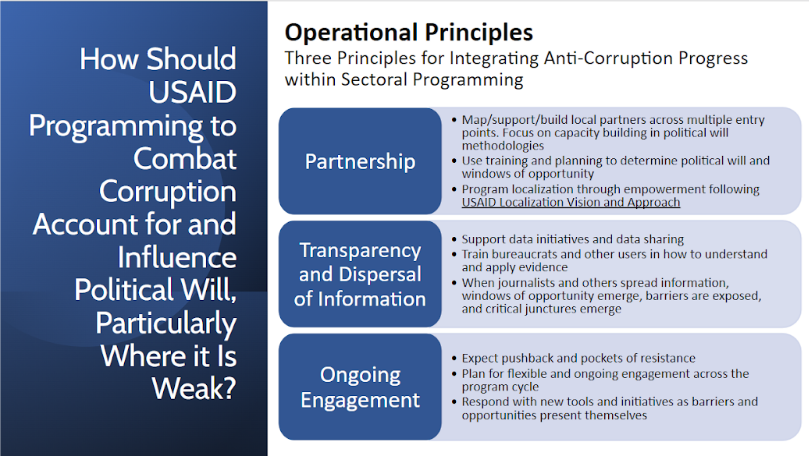 Three Operational Principles for Integrating Anti-Corruption Progress within Sectoral Programming. Source: Annual Learning Forum Session Slides
USAID’s DRG Center continues to support analysis and original research to improve anti-corruption outcomes. Additionally, USAID’s Anti-Corruption Task Force has produced several resources to help practitioners to operationalize these efforts, including the Dekleptification Guide and USAID Guide to Countering Corruption Across Sectors.
Careful Deployment of DRG Sub-Sector Tactics and Tools is Critical to Resisting Democratic Backsliding
As a third wave of autocratization has crested, key questions remain on how to forestall and reverse democratic backsliding. Experts from Cornell University, Georgia State University, and The Central European University joined the “What Do We Know About How to Support Democratic Openings?” session to share their preliminary findings on how to open up democratic spaces and forestall backsliding, including strategies related to different DRG sub-sectors. The research team detailed differences in the sequencing and nature of democratic breakdown, with recent erosions being driven more internally than externally and taking place incrementally over time. Recent declines are a result of democracy being threatened not by those who fear losing but more often by those who win elections and then seek to consolidate further power.
Pernicious polarization – the division of society into mutually distrustful “us” versus “them” camps in which political identity becomes a social identity – is associated with democratic erosion. Top-down polarization is more prevalent in democracy erosion, and polarized voters, especially strong partisans or those that feel highly threatened, are more likely to support anti-democratic policies and candidates. Other factors that fuel polarization include structural drivers – such as economic, demographic, technological, and cultural change – and institutional drivers. For example, consensus democracies are less polarized than majoritarian democracies. Agency is also a key factor, with polarizing political entrepreneurs using opportunities to expand democratic backsliding.
Different DRG sub-sectors present different opportunities and constraints to resist democratic backsliding. For example, effective strategies for civil society include: the importance of durable organizational networks that defend political autonomy; avoiding state cooptation, regulation, and control; contesting anti-democratic behavior by legal means without exacerbating polarization; and building broad democratic coalitions (different civic groups, political parties, etc.) to overcome political fragmentation and polarization. Institutional constraints that need to be accounted for include presidential term limits or the independence of the judiciary; the timing of relevant contextual factors also present opportunities or constraints to resist backsliding, such as rapid economic growth or recessions.
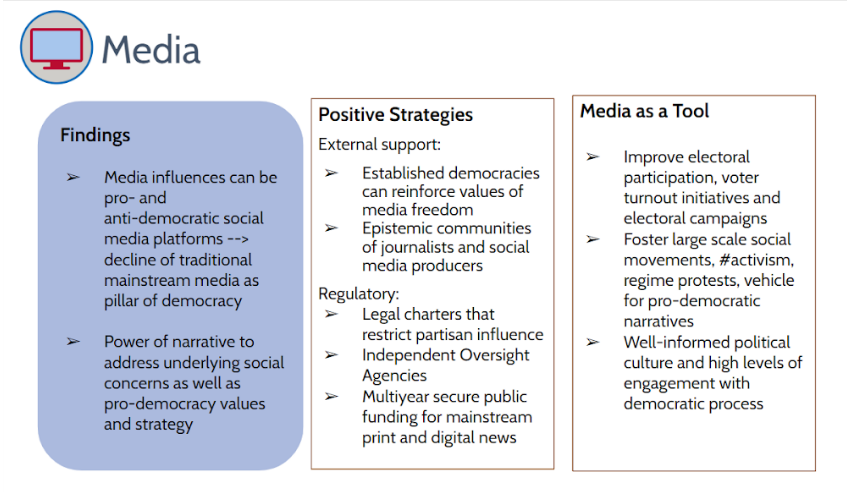 How to support democratic openings with media programming. Source: Annual Learning Forum Session Slides
This research builds on and helps to operationalize past research supported by the DRG Center, including in Theories of Democratic Backsliding, and further considered in USAID’s DRG Policy evidence review. The DRG Center research will continue to explore how sub-sector programming contributes to the larger goal of democratic resilience, and will be released later in 2023.
New Tools to Integrate Evidence, Evaluation, and Learning into DRG Programs
To facilitate practitioners understanding and applying social and behavior change (SBC) approaches in DRG programming, the “Guide to Social and Behavioral Change: Theory and Practice” salon introduced and discussed SBC approaches in DRG. The session emphasized the importance of focusing on behaviors as development outcomes, and understanding the individual, socio-cultural, and institutional drivers of those behaviors. The session drew on tools and resources such as the SBC in DRG Primer, and on how to make learning central in a SBC approach. Beyond the theory, participants heard from Dr. Kassidy Irvan on how the SBC approach can improve trust between citizens and municipal officials, specifically discussing how this approach is being applied in Kosovo. Collectively, this session showed how a comprehensive SBC approach can strengthen evidence-gathering and programming.
The “Recent Advances in Non-Experimental Research” salon shared lessons about how to use quasi-experimental methods to evaluate and learn from DRG programs. Quasi-experimental methods are useful to determine the impact of a program that cannot randomize where it is implemented. Rather than randomize an intervention between a treatment group and a control group, quasi-experiments use pre-existing data to identify a control group that is comparable to the treatment group. They have become increasingly common in academia – their methodological pioneers were awarded the 2021 Nobel Prize in economics – but are still relatively rare in DRG evaluations. The salon explored two examples of program evaluations: an ongoing quasi-experiment of an anti-corruption program in Peru that demonstrated the logistics of implementing a quasi-experimental evaluation, and a fully-randomized experimental evaluation of a tax program in Malawi that showed what the evaluation would have lost and gained if it had been quasi-experimental. Quasi-experimental evaluations are a great alternative to randomized experiments when randomization is not possible.
Finally, the “Is Our Work Evidenced-Based? How to Better Use Research Evidence in Activity Design” salon presented findings and built on recommendations from a recent USAID study on the use of evidence in the DRG sector. The session included examples of how research evidence could inform key design decisions, including prioritizing a DRG problem, understanding its causes, prescribing and refining the best programmatic approach, and targeting beneficiaries. Despite the potential benefits, the study found that research evidence is used far less frequently in DRG activity design than contextual and experiential evidence, and generally is not requested in procurement solicitations. Participants discussed different ways to take advantage of the growing evidentiary base and key resources, such as DRG evidence maps or the DRG Learning, Evidence, and Analysis Platform. (See guidance here). Much of the session centered around the pros and cons of including evidence requirements in solicitations, including how to discourage cherry-picked evidence, as well as how to avoid citations for citations’ sake and disadvantaging local organizations.
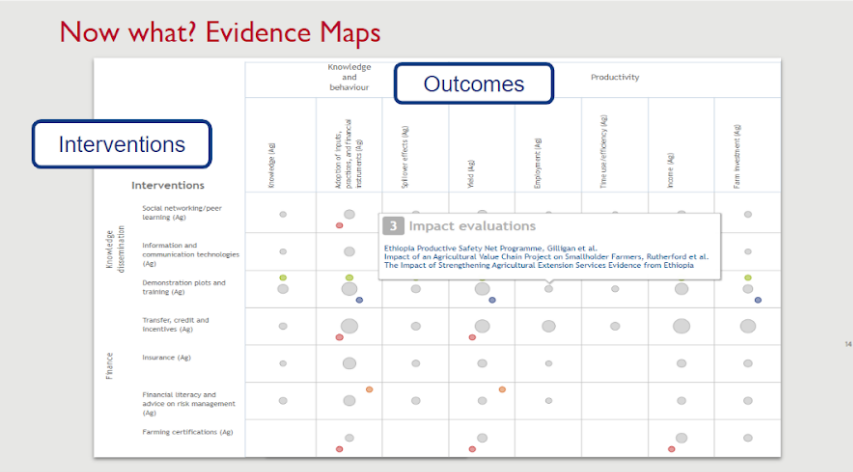 One example of a DRG evidence map. Source: Annual Learning Forum Session Slides
Stay tuned! Later this year, we will present the final results of the DRG Center’s 2021-2023 Learning Agenda research along with plans for the 2023-2025 DRG Learning Agenda!
Further Assistance
You can learn more about USAID’s DRG Learning Agenda and products by contacting the DRG Center’s Evidence and Learning Team (ddi.drg.elmaillist@usaid.gov).
Recent DRG Learning Events
Tuesday Group: Pro-Democratic and Pro-Authoritarian Narratives
On March 7, the Metropolitan Group (MG) presented findings from a year-long research activity that mapped pro-authoritarian and pro-democratic narratives, and shared actionable recommendations to tell more relevant and locally-resonant stories about democracy. MG’s research highlights how pro-authoritarian narratives are adept at using simple, emotive language that aligns with people’s closely-held values, while pro-democracy narratives often use highly technical language that fails to resonate. Evidence-based recommendations for more resonant narratives include making them value-based, culturally-relevant, accessible, asset-framed, and relational rather than transactional. At the core of the study is a SBC methodology that identifies narratives, the closely-held values that make narratives relevant and motivating, and the message framing that supports and advances narratives.
DRG Learning Community of Practice: Innovations in Evaluation: Lessons Using Participatory Video
On March 8, War Child Canada (WCC) joined the DRG Center to discuss their participatory video evaluation (PVE) methodology. Over the past two years, WCC has expanded, tested, and evaluated the method, producing guidance on how to apply it in DRG contexts. The PVE approach uses video as a data collection tool to engage beneficiaries in the assessment, monitoring, and evaluation of projects in their communities. The method opens channels for beneficiaries to contribute their voices to the evaluation process.
DRG Evidence and Learning Talk Series: V-Dem Democracy Report 2023
On March 15, the Varieties of Democracy (V-Dem) Institute joined the DRG Center to share their Democracy Report 2023: Defiance in the Face of Autocratization. The speakers presented evidence that the wave of autocratization is accelerating, engulfing 43 percent of the world population. The number of closed autocracies now surpasses that of liberal democracies for the first time since 1995. Rising polarization and disinformation as well as growing threats to freedom of expression, coupled with shifting global trade and energy interdependencies, make for a worrying picture. At the same time, V-Dem reported that in 2022 eight countries (Bolivia, Ecuador, Maldives, Moldova, North Macedonia, Slovenia, South Korea, and Zambia) reversed their long downward trends and that mobilization, popular protests, judicial autonomy, and critical elections are some of the elements uniting these cases of democracy “bouncing back.”
Use Our Resources!
Welcome to the DRG Learning Digest, a newsletter to keep you informed of the latest learning, evaluation, and research in the Democracy, Human Rights, and Governance (DRG) sector. Views expressed in the external (non-USAID) publications linked in this Digest do not necessarily represent the views of the United States Agency for International Development or the United States Government.
Don't forget to check out our DRG Learning Menu of Services! (Link only accessible to USAID personnel.) The Menu provides information on the learning products and services the Evidence and Learning Team offers to help you fulfill your DRG learning needs. We want to help you adopt learning approaches that emphasize best fit and quality.
The Evidence and Learning Team is also excited to share our DRG Learning, Evidence, and Analysis Platform (LEAP) with you. This Platform contains an inventory of programmatic approaches, evidence gap maps, the DRG Learning Harvest, and inventories of indicators and country data portraits - all of which can be very useful in DRG activity design, implementation, evaluation, and adaptation. Some of these resources are still being built, so check back frequently to see what has been newly added.
The DRG Learning Harvest on LEAP is a searchable database of DRG learning products, including summaries of key findings and recommendations, drop-down menus to easily find documents related to a particular country or program area, and links to the full reports on the DEC.
Our friends at the Varieties of Democracy (V-Dem) Institute are also seeking to expand their research partnership with USAID on the complex nature of democracy by inviting research questions from you for V-Dem to work on. If there's a DRG technical question you've been wondering about, please email the Evidence and Learning Team at ddi.drg.elmaillist@usaid.gov.
We welcome your feedback on this newsletter and on our efforts to promote the accessibility, dissemination, and utilization of DRG evidence and research. Please visit the DRG Center's website for additional information or contact us at ddi.drg.elmaillist@usaid.gov.
|